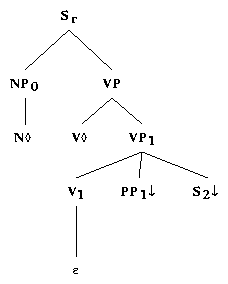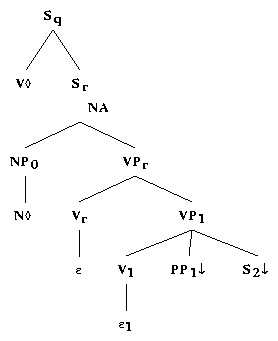

The clefted element can be of a number of categories, for example NP, PP or adverb. The clause can also be of several types. The English XTAG grammar currently has a separate analysis for only a subset of the `specificational' it-clefts12.1, in particular the ones without gaps in the clause (e.g. ((178)) and ((179))). It-clefts that have gaps in the clause, such as ((176)) and ((177)) are currently handled as relative clauses. Although arguments have been made against treating the clefted element and the clause as a constituent ([#!Delahunty84!#]), the relative clause approach does capture the restriction that the clefted element must fill the gap in the clause, and does not require any additional trees. In the `specificational' it-cleft without gaps in the clause, the clefted element has the role of an adjunct with respect to the clause. For these cases the English XTAG grammar requires additional trees. These it-cleft trees are in separate tree families because, although some researchers (e.g. [#!Akmajian70!#]) derived it-clefts through movement from other sentence types, most current researchers (e.g. [#!Delahunty84!#], [#!Knowles86!#], [#!gazdar85!#], [#!Delin89!#] and [#!Sornicola88!#]) favor base-generation of the various cleft sentences. Placing the it-cleft trees in their own tree families is consistent with the current preference for base generation, since in the XTAG English grammar, structures that would be related by transformation in a movement-based account will appear in the same tree family. Like the base-generated approaches, the placement of it-clefts in separate tree families makes the claim that there is no derivational relation between it-clefts and other sentence types. The three it-cleft tree families are virtually identical except for the category label of the clefted element. Figure 12.1 shows the declarative tree and an inverted tree for the PP It-cleft tree family.
 |
0.5in |  |
| (a) | 0.5in | (b) |
The extra layer of tree structure in the VP represents that, while be is a main verb rather than an auxiliary in these cases, it retains some auxiliary properties. The VP structure for the equative/it-cleft-be is identical to that obtained after adjunction of predicative-be into small-clauses.12.2 The inverted tree in Figure 12.1(b) is necessary because of be's auxiliary-like behavior. Although be is the main verb in it-clefts, it inverts like an auxiliary. Main verb inversion cannot be accomplished by adjunction as is done with auxiliaries and therefore must be built into the tree family. The tree in Figure 12.1(b) is used for yes/no questions such as ((180)).